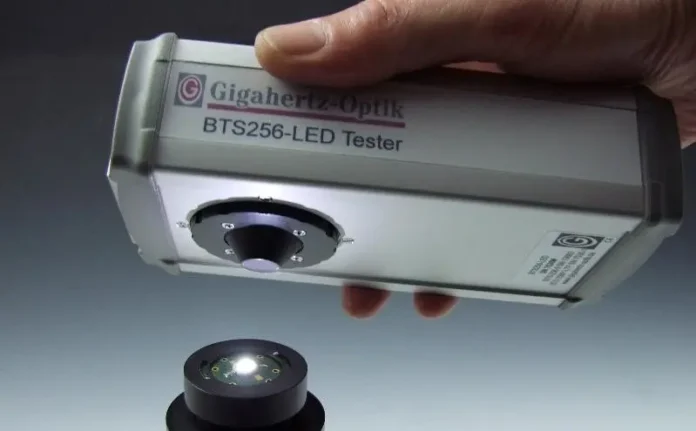Press release submitted on behalf of Gigahertz-Optik.
Gigahertz-Optik, Amesbury, Massachusetts, introduced two new versions of its highly successful BTS256-LED Tester. These compact portable ‘BiTec Sensor’ spectral radiant power measurement devices focus on single UV or IR LEDs. As with the now standard BTS256-LED Tester for photometric, colorimetric and spectral radiometric testing in the visible spectral region, these new testers include a built-in integrating sphere with cone-shaped measurement port enabling hand-held or fixtured testing of PCB mounted LEDs for radiant power, SPD, peak intensity and more, plus an on-board UV or IR auxiliary LED for absorption correction under software control typically only found on fixed bench-top LED measurement systems.
These testers allow the user to bring the measurement tool to the test LED for use in either in a hand-held or fixtured set-up in incoming QC, R&D, production control or other test applications.
The BTS256-LED-UV calibrated spectral range is 200 to 550 nm with a bandwidth of 5 nm (optical bandwidth correction per CIE 214). It measures radiant power levels from 10 µW to 2 W (typ. 350 nm LED).
The BTS256-LED-IR calibrated spectral range is 750 to 1100 nm with a bandwidth of 5 nm (optical bandwidth correction per CIE 214). It measures radiant power levels from 0.3 µW to 5 W (typ. 900 nm LED).
The testers are operated and fully controlled using the supplied S-BTS256 application software which allows device settings like integration time, measurement settings, mathematical corrections, evaluations and all other functions.
Traceable calibration and certification of the BTS256-LED testers is performed in Gigahertz-Optik’s ISO/IEC 17025 calibration laboratory that is accredited by DAkkS (D-K-15047-01-00) for the spectral responsivity and spectral irradiance according to ISO/IEC 17025. The device receives two calibrations: one is done using a specially developed reference lamp offering 2 pi illumination which enables precise measurement of the luminous flux of diffusely emitting LEDs. The second calibration is for sources that have narrower illumination characteristics.
Also, for other visible spectral photometric, colorimetric and radiometric LED measurement applications explore the BTS256-LED Plus Concept that shows how to extend usage of a BTS256-LED Tester.
For more information, visit www.gigahertz-optik.com.







